Saturday, March 19, 2022 – Casseroles
- Mary Reed

- Mar 19, 2022
- 14 min read

The photo is of a beef enchilada casserole I made recently for the United Methodist Church-sponsored Wesley-Rankin Community Center that — in collaboration with its West Dallas neighbors — identifies and bridges gaps in education, health and skills development by providing multigenerational programs that empower families to access their full potential. I have eaten a lot of casseroles in my lifetime — lasagna, baked ziti, King Ranch chicken, chicken spaghetti, Frito chili pie, tuna noodle with crushed potato chips on top, goulash, macaroni and cheese, green bean with canned crispy fried onions, potatoes au gratin, moussaka – a Greek dish with eggplant, sweet potato with marshmallows on top, etc. A casserole can be a quick and easy way to prepare a nightly meal or side dish. There is a wide variety of casseroles with or without meat made according to various cultural traditions from a multitude of countries. Let’s learn more about casseroles.
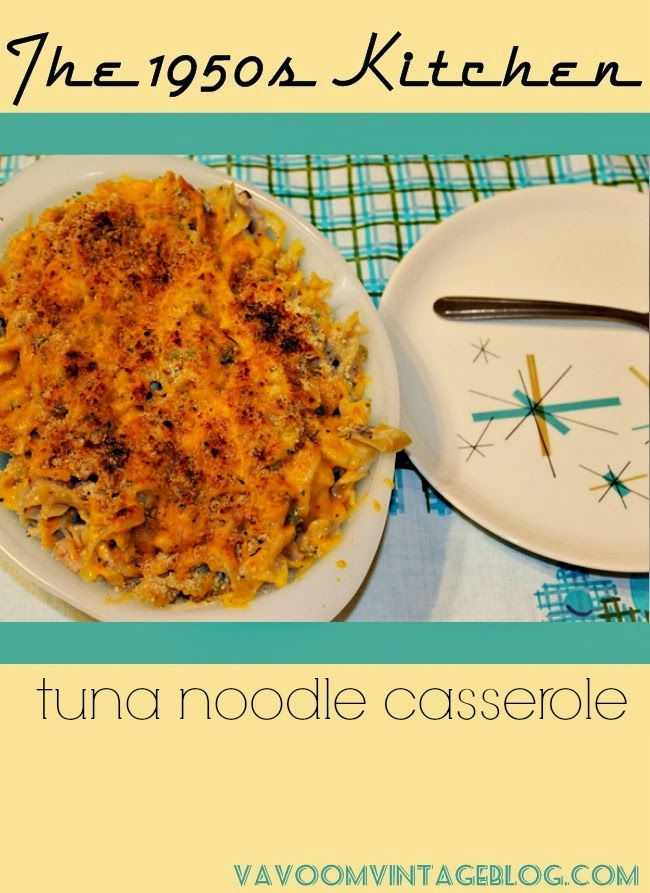
History
Baked dishes have existed for thousands of years. Early casserole recipes consisted of rice that was pounded, pressed and filled with a savory mixture of meats such as chicken or sweetbread. Some time around the 1870s this sense of casserole seems to have taken its current sense. Cooking in earthenware containers has always been common in most cultures, but the idea of casserole cooking as a one-dish meal became popular in the United States in the 20th century, especially in the 1950s when new forms of lightweight metal and glass cookware appeared on the market. By the 1970s casseroles took on a less-than-sophisticated image.
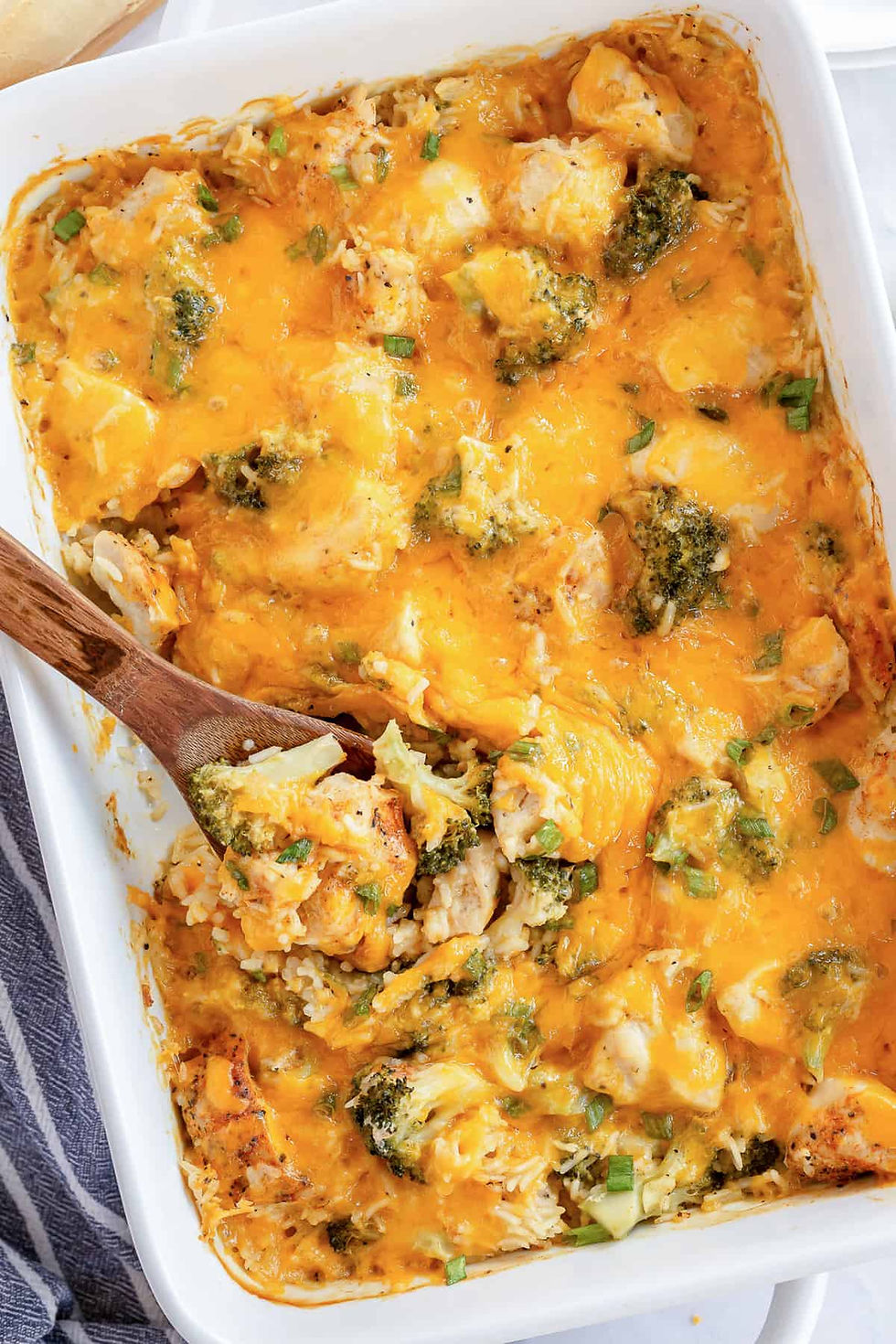
American-style casserole
In the United States, a casserole or hot dish is typically a baked food with three main components: pieces of meat (such as chicken or ground meat) or fish (such as tuna) or other protein (such as beans or tofu), various chopped or canned vegetables (such as green beans or peas) and a starchy binder (such as flour, potato, rice or pasta); sometimes, there is also a crunchy or cheesy topping. Liquids are released from the meat and vegetables during cooking, and further liquid in the form of stock, wine, beer, gin, cider, vegetable juice or even water may be added when the dish is assembled. Casseroles are usually cooked slowly in the oven, often uncovered. They may be served as a main course or side dish and, conveniently, may be served in the vessel in which they were cooked.
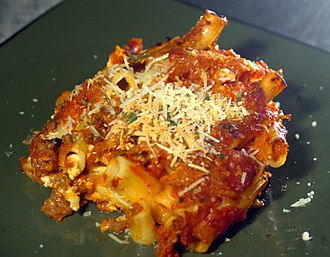
Other cuisines
Many baked dishes served in the baking dish can be classed as casseroles. Examples include: Lancashire hotpot (English), cassoulet (French), moussaka (Greek) and timballo (Italian).
In English-speaking Commonwealth countries like the United Kingdom, Australia and New Zealand, the term casserole is most commonly used to refer to a dish of meat or chicken with vegetables and a gravy-style sauce; dishes containing a large proportion of starchy ingredients e.g., pasta or potatoes, or those cooked in creamy sauces are not generally referred to as casseroles and might be called “bakes” or “gratins.” In the UK, the terms casserole and stew tend to be used interchangeably, although technically stews are cooked on a stovetop while casseroles are cooked in an oven.
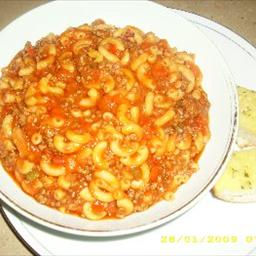
American goulash
American goulash, sometimes called slumgullion, is an American comfort food dish, similar to American chop suey. American goulash is usually referred to in the midwestern and southern United States as simply "goulash." As a descendant, of sorts, of Hungarian goulash, the only real connection seems to be the name and the inclusion of beef and paprika.
American goulash, mentioned in cookbooks since at least 1914, exists in a number of variant recipes. Originally a dish of seasoned beef, core ingredients of American goulash now usually include various kinds of pasta, usually macaroni or egg noodles; ground beef cooked with any number of aromatics, usually onions and garlic; along with tomatoes of some sort, whether canned tomatoes — whole, diced or crushed are all common variants, tomato sauce or tomato paste. Some variations of American goulash include cheese.
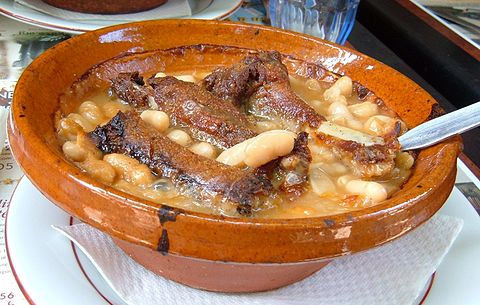
Cassoulet
Cassoulet is a rich, slow-cooked casserole containing meat — typically pork sausages, goose, duck and sometimes mutton, pork skin or couennes and white beans or haricots blancs, originating in southern France. It is named after its traditional cooking vessel, the casserole, a deep, round, earthenware pot with slanting sides.

The dish is said to have originated in the town of Castelnaudary and is particularly popular in the neighboring towns of Toulouse and Carcassonne. It is associated with the region once known as the province of Languedoc. An organization called The Grand Brotherhood of the Cassoulet of Castelnaudary has organized competitions and fairs featuring cassoulet every year since 1999.
All cassoulets are made with white beans — French: haricots blancs or lingots — duck or goose confit, sausages and additional meat. In the cassoulet of Toulouse, the meats are pork and mutton, the latter frequently a cold roast shoulder. The Carcassonne version is similar but doubles the portion of mutton and sometimes replaces the duck with partridge. The cassoulet of Castelnaudary uses a duck confit instead of mutton.
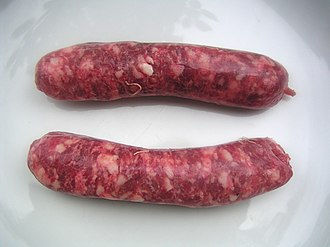
In France, cassoulets of varying price and quality are also sold in cans and jars in supermarkets, grocery stores and delicatessens. The cheapest ones contain only beans, tomato sauce, sausages and bacon. More expensive versions are likely to be cooked with goose fat and to include Toulouse sausages, lamb, goose or duck confit.
Haute cuisine versions require mixing precooked roasted meats with beans that have been simmered separately with aromatic vegetables, but this runs counter to cassoulet's peasant origins. In the process of preparing the dish it is traditional to deglaze the pot from the previous cassoulet in order to give a base for the next one. This has led to stories — such as the one given by Elizabeth David, citing Anatole France — of a single original cassoulet being extended for years or even decades.
In U.S. restaurants, the term cassoulet is often applied to any hearty bean-based casserole, with variations such as salmon cassoulet.

Chicken Divan
Chicken Divan is a chicken casserole usually served with broccoli and Mornay sauce. It was named after the place of its invention, the Divan Parisien Restaurant in the New York City Chatham Hotel where it was served as the signature dish in the early 20th century. Its creator was a chef named Lagasi. In French, the word divan refers to a meeting place or great hall.
The dish is now commonly prepared with regular Parmesan cheese and remains one of the most classic American casserole dishes today. A "quick" version can be made with precooked chicken breasts, prepared mayonnaise and canned soup. Some versions are topped with potato chips, in a manner similar to that of funeral potatoes, a traditional potato hotdish or casserole that is popular in the American Intermountain West and Midwest. It is called "funeral" potatoes because it is commonly served as a side dish during traditional after-funeral dinners.
There are many historic recipes for Chicken Divan found in cookbooks dating to the late 1950s and early 1960s, but their authenticity is uncertain since the original recipe was kept a secret. An approximation based on hints from the maître d'hôtel of the Divan Parisien is made with poached chicken breasts, broccoli and a cheesy béchamel or Mornay sauce, enriched with egg yolks.

Chili mac
Chili mac is a dish prepared using chili con carne and macaroni as primary ingredients, which is often topped or intermingled with cheese. Some versions are made using prepared or homemade macaroni and cheese. It is a common dish in the cuisine of the Midwestern United States and is also popular in other areas of the United States.
Several variations of the dish exist, and prepared canned and boxed versions also exist. It can be a relatively inexpensive dish to prepare and has been described as a comfort food. Similar dishes include Spaghetti Red, a chili-topped spaghetti popular around Joplin, Missouri and Cincinnati chili.
Several preparation methods exist. Basic versions may be prepared using chopped meat, tomato, spices and elbow macaroni. Another basic preparation method incorporates boxed, prepared macaroni and cheese and canned chili. Some recipes incorporate all of the ingredients together, while others are prepared with the ingredients separately layered. Those that use cheese may use grated cheese atop the dish, while others mix the cheese throughout the dish. Sometimes, onions or beans are added. Some diners in St. Louis, Missouri, serve a version called "chili mac a la mode," in which the dish is served topped with fried eggs.
The dish may be prepared on a range top in a skillet, in a slow cooker or baked as a casserole. Vegetarian and vegan versions of the dish are sometimes prepared.
Chili mac has been a staple dish at American military dining facilities for years. It was introduced into the Meal, Ready-to-Eat or MRE field ration menu in 1995 and is one of only three of the 12 MRE meals offered in 1995 that has remained on the MRE menu to date. A variation called "taco chili mac" has been consumed by NASA astronauts in space. It is processed by NASA as a freeze-dried product.
Hamburger Helper sells a boxed version named "Chili Macaroni."
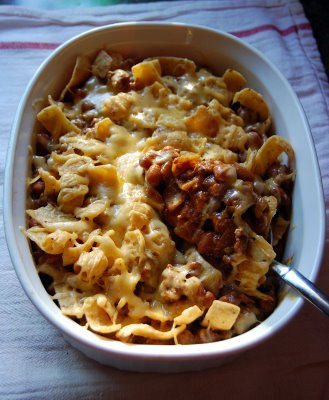
Frito chili pie
Frito pie is a dish popular in the Midwestern, Southeastern and Southwestern United States. Its basic ingredients are chili, cheese and corn chips — traditionally Fritos. Additions can include salsa, refried beans, sour cream, onion, rice or jalapeños. There are many variations and alternative names used by region. Frito pie can be prepared in a casserole dish, but an alternate preparation can be in a single-serve Fritos-type corn chip bag with various ingredients as toppings. In Mexico a similar type of dish is chilaquiles.
The exact origin of the frito pie is not completely clear. It is believed that it was created somewhere in Mexico and was popular at fiestas before taking off in other countries like the United States.
The oldest known recipe using Fritos brand corn chips with chili was published in Texas in 1949. The recipe may have been invented by Daisy Doolin, the mother of Frito Co. founder Charles Elmer Doolin and the first person to use Fritos as an ingredient in cooking or by Mary Livingston, Doolin's executive secretary. Frito-Lay Inc. attributes the recipe to Nell Morris, who joined Frito-Lay in the 1950s and helped develop an official cookbook which included the Frito pie.
Charles Doolin and his Frito Co. were early investors in Disneyland, which opened Casa de Fritos restaurant in Disneyland in 1955. "Frito Chili Pie" appears on the 1950s menu.

Another story claims that true frito pie originated only in the 1960s with Teresa Hernández, who worked at the Woolworth's lunch counter in Santa Fe, New Mexico. Her frito pie used homemade red chili con carne with cheddar cheese and onions and was served in the bag, which was thicker in the 1960s than it is now.
Frito pie is a simple dish: at its most basic, it is Frito corn chips with beef chili as a topping. It was historically served right inside the chip bag, which is split down the middle; toppings typically include shredded cheese and chopped raw onion and may also include additional items like sour cream and jalapeños.
Frito pies are sometimes referred to by the name walking taco or Frito boat and can be made in a small, single-serving bag of corn chips with chili, taco meat, chickpeas, pork rinds, pepitas and many other various ingredients, poured over the top. The combination can be finished with grated cheese, onions, jalapeños, lettuce and sour cream, known as a Frito boat or walking taco in the Midwestern United States. In the Ohio Valley region, this preparation is commonly called taco-in-a-bag. "Walking taco" or "traveling taco", however, is the more widespread term — at least in the Midwest. In many parts of Southern California, they are known as "pepper bellies." Frito pies are popular at sports venues, fundraisers, bingos, open houses, state fairs and with street vendors. The term Tostiloco comes from Tijuana and is found in California. Another term is Doriloco, after Doritos.
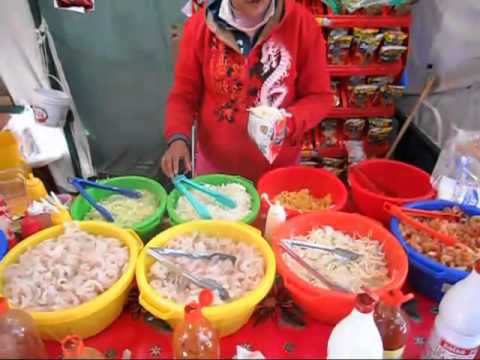
In Mexico, a version of the dish is known as tostilocos or "crazy chips." It is topped with cueritos, cucumber, jícama, lime juice, Valentina hot sauce, chamoy, Tajín chili powder, salt and "Japanese peanuts" or “cracker nuts,” a snack food made from peanuts that are coated in a wheat flour dough and then fried or deep-fried.
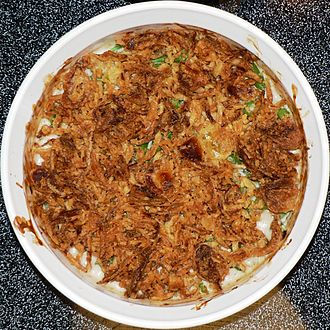
Green bean casserole
Green bean casserole is a baked dish consisting primarily of green beans, cream of mushroom soup and french fried onions. The recipe was created in 1955 by Dorcas Reilly at the Campbell Soup Co. It is a very popular side dish for Thanksgiving dinners in the United States and has been described as iconic. As of 2020 Campbell's estimated it was served in 20 million Thanksgiving dinners in the U.S. each year and that 40% of the company's cream of mushroom soup sales go into a version of the dish.
Campbell’s Cream of Mushroom flavored soup variety was created in 1934 and was the first of the company's soups to be marketed as a sauce as well as a soup. It became so widely used as casserole filler in recipes for the hotdish recipes popular in Minnesota that it was sometimes referred to as "Lutheran binder." Like other food companies, Campbell's employed recipe developers to create recipes using their products as part of their marketing strategy.

Dorcas Reilly (1926–2018) created the recipe in 1955 while working in the home economics department at the Campbell Soup Co. The recipe was created for a feature article for the Associated Press; the requirement was for a quick and easy dish using ingredients most U.S. households kept on hand.
It was called "Green Bean Bake" when the recipe began being printed on soup cans. Initially the dish did not test well within the company but — in part because of Reilly's persistence — eventually earned a reputation for being "the ultimate comfort food." Culinary historian Laura Shapiro called the recipe's use of the crunchy fried onion topping a "touch of genius" that gave an otherwise ordinary convenience-food side dish a bit of "glamour."
Food & Wine called it iconic, and Good Housekeeping said that "few dishes are as iconic" as the green bean casserole.

It was originally marketed as an everyday side dish but became popular for Thanksgiving dinners in the 1960s after Campbell's placed the recipe on the can's label. The recipe popularized the combination of the soup with green beans. Campbell's in 2020 reported their online version of the recipe is viewed 4 million times each Thanksgiving Day. According to Campbell's as of 2018, the recipe is the most popular ever developed in its kitchens.
Folklorist Lucy Long in 2007 noted that its inclusion on Thanksgiving dinner tables crosses ethnic, socioeconomic and religious differences. She also notes it is included in most popular American cookbooks mentioned in the media regularly and is referred to as a "classic," "traditional" and "a Thanksgiving standard." She wrote that the popularity of the dish was related to its categorization as a casserole, which in the U.S. is associated with "communal eating, sharing and generosity" and that the green bean casserole in particular represents the familiar and also the festive.
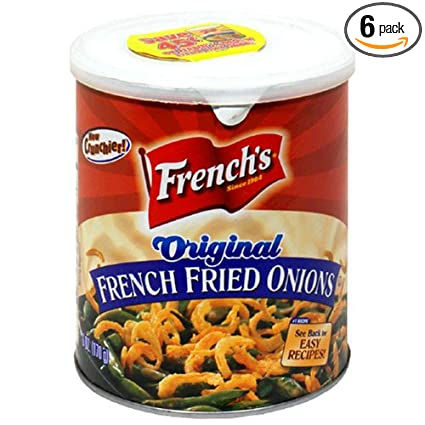
The recipe, which hasn't changed, calls for green beans, mushroom soup, milk, soy sauce, ground black pepper and french fried onions. The beans, soup, milk and seasonings are mixed together with a portion of the onions and baked, then topped with more onions and baked for another few minutes.
Multiple similar recipes have been developed that "update" or "upgrade" the original recipe to use fresh beans, homemade cream sauce and fresh mushrooms as the convenience-food based recipes of the 1950s and 1960s have become less fashionable, but according to culinary historian Shapiro, the green bean casserole remains popular for Thanksgiving for reasons of nostalgia. Other recipes have been developed by Campbell's and others that incorporate a variety of ingredients in addition to — or in replacement of — those in the original.
In November of 2002, Reilly, representing Campbell's, donated the original recipe card to the National Inventors Hall of Fame in Akron, Ohio. The donation was followed by a meal featuring the dish. Reilly died October 15, 2018, at the age of 92 in her hometown of Camden, New Jersey.
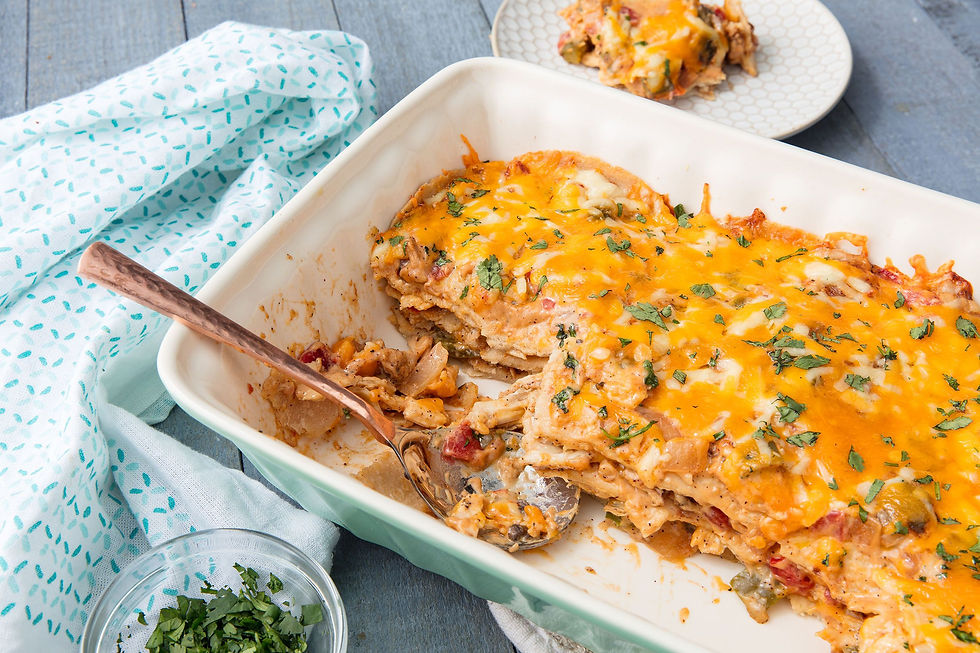
King Ranch chicken
King Ranch chicken is a popular Tex-Mex casserole. Its name comes from King Ranch — one of the largest ranches in the United States — although the actual history of the dish is unknown and there is no direct connection between the dish and the ranch. Recipes vary, but generally it has a sauce made of canned diced tomatoes — commonly the Ro-Tel brand — with green chiles, cream of mushroom soup, cream of chicken soup, diced bell pepper, onion and chunks or shreds of chicken. The bottom of the casserole is lined with corn tortillas or tortilla chips, then layered with sauce and topped with cheese. This flavorful Tex-Mex dish has long been a favorite dish in Texas club cookbooks and lunchrooms.
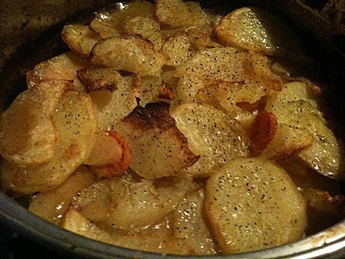
Lancashire hotpot
Lancashire hotpot is a stew originating from Lancashire in the northwest of England. It consists of lamb or mutton and onion, topped with sliced potatoes or a more traditional topping of pastry or puff pastry and baked in a heavy pot on a low heat.
In Lancashire before industrialization, families would work at home spinning thread while scrags — a cut of lamb and mutton taken from the neck and popular in the United Kingdom — stewed slowly over a low fire. Family members could attend to the cooking over many hours. In the initial stages of industrialization and urbanization, both men and women of all ages had long, strictly regulated work hours that made it impossible to cook food that required extensive attention and preparation time. Often lacking their own cooking facilities, housewives would carry a pudding or stew to the baker's oven and leave it there to cook.
The recipe usually calls for a mix of mutton — nowadays more frequently lamb — and onions covered with sliced potato. Many regional variations add vegetables such as carrots, turnips or leeks. Many early recipes add lamb kidneys and modern variants may use beef or bacon chops instead of lamb or have a pastry topping.
The traditional recipe once included oysters, but increasing cost eliminated them from common usage. Pickled red cabbage or beetroot — and in some areas Lancashire cheese — are often served as an accompaniment.
It is often thought that the "hot pot" referred to is a pottery dish used to cook casseroles in British cuisine. However, it is more likely to refer to the idea of a jumble or hodge podge of ingredients in the filling. Sir Kenelm Digby's 1677 “The Closet Opened” contains a recipe for the "Queen Mother’s Hotchpot of Mutton." Similarly, “Mrs. Beeton's Cookery Book” contains a recipe for "Hotch Potch," calling for neck of mutton, onion, carrot, peas, cauliflower and lettuce.

Moussaka
Moussaka is an eggplant- or potato-based dish, often including ground meat, which is common in the Balkans and the Middle East, with many local and regional variations.
The best-known version in Europe and the Americas is the Greek variant created in the 1920s by Nikolaos Tselementes. Many versions have a top layer made of milk-based sauce thickened with egg (custard) or flour (béchamel sauce). In Greece, the dish is layered and typically served hot.

The versions in Egypt, Turkey and the rest of the Middle East are quite different. In Egypt, Messa'aa can be made vegan or vegetarian as well as with meat; in all cases, the main ingredient is the fried eggplant. In Turkey, mussaka consists of thinly sliced and fried eggplant served in a tomato-based meat sauce, warm or at room temperature. In Saudi Arabia muṣagga‘a is eaten hot, but in other Arab countries, it is often eaten cold, but occasionally hot as well.
Vegan variants are prepared for fast days.
The English name for moussaka was borrowed from Greek mousakás and from other Balkan languages, all borrowed from Ottoman Turkish, which in turn borrοwed it from Arabic muṣaqqa‘a (مصقعة, lit. 'pounded' or 'cold'). The word is first attested in English in 1862, written mùzàkkà.
Most versions are based primarily on sautéed aubergine or eggplant and tomato, usually with minced meat, mostly lamb. The Greek version includes layers of meat and eggplant topped with a béchamel or "white" sauce and baked.
The modern Greek version was created by the French-trained Greek chef Nikolaos Tselementes in the 1920s. His recipe has three layers that are separately cooked before being combined for the final baking: a bottom layer of sliced eggplant sautéed in olive oil; a middle layer of ground lamb lightly cooked with chopped or puréed tomatoes, onion, garlic and spices of cinnamon, allspice and black pepper; and a top layer of béchamel sauce or savory custard.
There are variations on this basic recipe, sometimes with no top sauce, sometimes with other vegetables. Such variants may include — in addition to the eggplant slices — sautéed zucchini slices, part-fried potato slices or sautéed mushrooms. There is a fast-day vegan version in Tselementes' cookbook which includes neither meat nor dairy products — just vegetables (ground eggplant is used instead of ground meat), tomato sauce and bread crumbs.

Another variant is papoutsakia — lit. ”eggplant, little shoe style” — which consists of whole small eggplant stuffed with ground meat and topped with béchamel and baked.
In Albania, Bulgaria, the former Yugoslavia and Romania, potatoes are used instead of eggplant, pork or beef mince, and the top layer is usually milk or yogurt mixed with raw eggs, sometimes with a small amount of flour added. There is also a three-layer version: the bottom layer consists of ground pork and beef, the middle layer of potato slices, and the top layer is typically a custard. Each layer is cooked on its own and layered in a pan and baked until the top is browned.
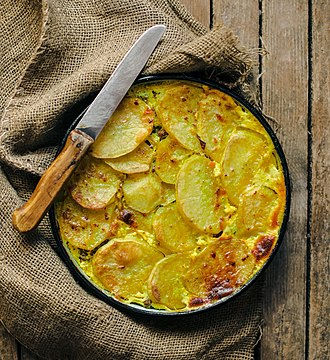
The Romanian version is made usually with potatoes or eggplant or cabbage. The layers start with the vegetable, then the layer of meat — usually pork, then vegetables, until the pot is full. Sometimes bread crumbs are used for toppings, sometimes slices of tomatoes and crushed cheese. The pot is then filled with tomato sauce. There is also a pasta variant, with pasta being used instead of vegetables. The "fasting" variant, which is vegan, replaces meat with mushrooms or a mix of sautéed onions and rice.
In the rest of the Balkans, the top layer is often a custard: this is the version introduced in the UK by Elizabeth David's “Mediterranean Cookery” and where it remains the usual presentation. Grated cheese or bread crumbs are often sprinkled on top.
The Egyptian version of moussaka is made from layers of fried eggplant immersed in tomato sauce and then baked. A layer of seasoned cooked ground beef is usually added between the eggplant before baking. The dish can be served hot but is usually chilled for a day or so to improve the taste.
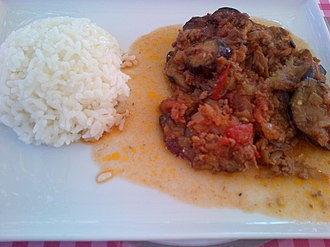
Turkish musakka is not layered. Instead, thinly sliced eggplant is fried and served in tomato-based meat sauce seasoned with green peppers, garlic and onions. It is generally eaten with pilav and cacık. There are also variants with zucchini, carrots and potatoes.




Comments